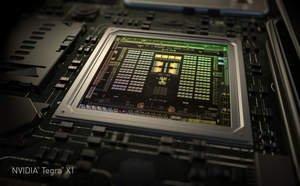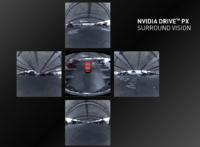Car Stuff @ CES 2015 -Tegra X1 Mobile Super Chip
 |
But First Snide's Remarks: With your next car or maybe the next one after that a highway rated computer that will not only drive for you and order your takeout food and find a parking space and order the flowers you forgot to order and keep your vehicle connected to every device you own both at home and away, I thought you car guys and gals might like to see what the electronics biz is showing at the 2015 CES show in Las Vegas that will allow your car to be transformed into a four wheel "mobile device". Comments? msnide@theautochannel.com
Powered by Tegra X1, DRIVE PX Auto-Pilot and DRIVE CX Cockpit Computers Deliver Computer Vision, Deep Learning, Unprecedented Graphics in Cars
 |
Transporting the world closer to a future of auto-piloted cars that see and detect the world around them, NVIDIA today introduced NVIDIA DRIVE™ automotive computers – equipped with powerful capabilities for computer vision, deep learning and advanced cockpit visualization.
NVIDIA will offer two car computers: NVIDIA DRIVE PX, for developing auto-pilot capabilities, and NVIDIA DRIVE CX, for creating the most advanced digital cockpit systems. These automotive-grade in-vehicle computers are based on the same architecture used in today's most powerful supercomputers.
"Mobile supercomputing will be central to tomorrow's car," said Jen-Hsun Huang, CEO and co-founder, NVIDIA. "With vast arrays of cameras and displays, cars of the future will see and increasingly understand their surroundings. Whether finding their way back to you from a parking spot or using situational awareness to keep out of harm's way, future cars will do many amazing, seemingly intelligent things. Advances in computer vision, deep learning and graphics have finally put this dream within reach.
"NVIDIA DRIVE will accelerate the intelligent car revolution by putting the visual computing capabilities of supercomputers at the service of each driver."
NVIDIA DRIVE PX
The NVIDIA DRIVE PX auto-pilot development platform provides the technical foundation for cars with completely new features that draw heavily on recent developments in computer vision and deep learning.
DRIVE PX leverages the new NVIDIA® Tegra® X1 mobile super chip, which is built on NVIDIA's latest Maxwell™ GPU architecture and delivers over one teraflops of processing power, giving it more horsepower than the world's fastest supercomputer of 15 years ago. DRIVE PX, featuring two Tegra X1 super chips, has inputs for up to 12 high-resolution cameras, and can process up to 1.3 gigapixels per second.
Its computer vision capabilities can enable Auto-Valet, allowing a car to find a parking space and park itself, without human intervention. While current systems offer assisted parallel parking in a specific spot, NVIDIA DRIVE PX can allow a car to discover open spaces in a crowded parking garage, park autonomously and then later return to pick up its driver when summoned from a smartphone.
The deep learning capabilities of DRIVE PX enable a car to learn to differentiate various types of vehicles -- for example, discerning an ambulance from a delivery van, a police car from a regular sedan, or a parked car from one about to pull into traffic. As a result, a self-driving car can detect subtle details and react to the nuances of each situation, like a human driver.
More about the Tegra X1 at CES , a mobile super chip that packs a full teraflop of computing power into a slice of silicon no bigger than a thumbnail. How’s that for a game with high table stakes?
In the first big news of this year’s International Consumer Electronics Show, NVIDIA CEO Jen-Hsun Huang unveiled the new 256-core chip, which uses the same Maxwell architecture deployed in the world’s top gaming graphics cards. Slated to arrive in products during the first half of the year, Tegra X1 provides more power than a supercomputer the size of a suburban family home from 15 years ago.
Next up, he showed what Tegra X1 can do by revealing NVIDIA DRIVE computers for the car.
“Your future cars will be the most advanced computers in the world,” Jen-Hsun told a crowd of more than 350 reporters, analysts and partners packed into a ballroom at The Strip’s Four Season’s Hotel. “There will be more computing horsepower inside a car than anything you own today.”
NVIDIA DRIVE PX is a radical step toward the era of auto-piloted cars. Powered by dual Tegra X1 processors, DRIVE PX, with inputs for 12 high-resolution camera, promises to make driving safer and more enjoyable by introducing Surround-Vision and Auto-Valet capabilities.
NVIDIA DRIVE CX is a cockpit computer that can drive next-gen infotainment systems by lighting up to nearly 17 million pixels, better than 10-times the number in current state-of-the-art cars.
Jen-Hsun offered a stunning demonstration of DRIVE PX by using his smartphone to set a virtual car loose in a photorealistic digital garage.
The car wove its way through the garage, using computer vision to find an open space. Jen-Hsun could then call it back with the touch of a button.
“When you’re done with diner you say can come back to me… and it becomes ann auto-valet,” Jen-Hsun says. “That car meanders back out and gets back to the driver.“
Jen-Hsun also showed how the NVIDIA DRIVE CX cockpit computer can run stunning next-generation digital instrument clusters and infotainment systems inside the car.
Using NVIDIA DRIVE Studio software, designers can create digital cockpits that integrate features such as navigation and infotainment with next-generation driver aids such as Surround Vision, which gives drivers a top-down 360-degree view of the car in real time. Jen-Hsun showed how DRIVE Studio lets designers sculpt razor-sharp 3D digital cockpits that mimic the look and feel of real materials, from aluminum to carbon fiber and even bamboo.
Available with either Tegra X1 or Tegra K1 processors, and complete road-tested software, the DRIVE CX can power up to 16.8 million pixels on multiple displays – more than 10 times that of current model cars.
An Unreal Demo
Even without wheels, Tegra X1 packs plenty of horsepower. One highlight
from the event: Jen-Hsun showed
Epic Games’ Elemental demo running on a Tegra X1 mobile
processor.
It’s just the latest example of how we’re erasing the lines between mobile and desktop GPUs.
The 256-core processor provides twice the performance and twice the power efficiency of its Kepler-based predecessor, Tegra K1, which debuted at last year’s CES.
A Supercomputer You Can Slide Into Your Pocket
The result is supercomputer-class performance. Tegra X1 packs more power
than the fastest supercomputer of 15 years ago, ASCI Red.
Run for 10 years by the U.S. Department of Energy’s Sandia National Laboratory, ASCI Red was the first teraflops supercomputer system.
ASCI Red occupied 1,600 square feet and gulped 500,000 watts of power. By contrast Tegra X1 sips less than 15 watts of power.
Not a bad way to roll.


